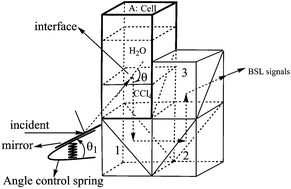We report on the construction of a backscattering light (BSL) detection assembly based on detecting angle-dependent light scattering signals, by changing the sample chamber of a common spectrofluorometer. The BSL detection assembly was used to detect, with high sensitivity, the analyte concentrated at the liquid/liquid interface. We applied this assembly to study the interaction of proteins with quercetin in the presence of cationic surfactant. The species resulting from the interaction of quercetin with proteins, when concentrated at the H2O/CCl4 interface, generate enhanced BSL signals characterized at 376.0 nm which were found to be proportional to human serum albumin (HSA) and bovine serum albumin (BSA) in the range of 1–1250 ng mL−1 and 2–1250 ng mL−1, respectively. Limits of determination (3σ) of 75 and 180 pg mL−1 are reported for the two proteins.
You have access to this article
 Please wait while we load your content...
Something went wrong. Try again?
Please wait while we load your content...
Something went wrong. Try again?


 Please wait while we load your content...
Please wait while we load your content...